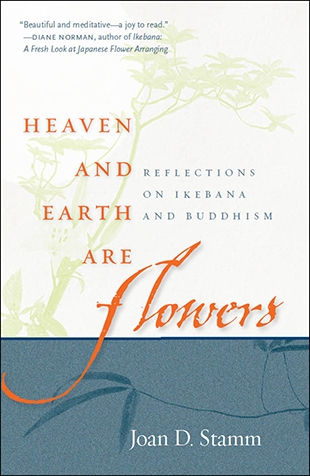Joan Stamm, who lives on Orcas Island, Washington, inherited from her mother a love of flowers and the joy they bring into our lives. For eight years the author assisted African, Middle Eastern, and Russian refugees in achieving their goal of U.S. citizenship. Hearing the accounts of their suffering and pain drained her, and she took up ikebana along with her other studies of Buddhism. Here's how she describes this art of flower arranging:
"These words — 'flower arranging' — do not begin to describe the complex system of rules, artistic principles, and symbolic meaning found in this art form. By observing the beauty and quietude of nature; the play of opposites, of yin and yang (in and yo in Japanese); and the asymmetrical balance of line, mass, and empty space, the ikebana practitioner strives to incorporate peace, harmony, reverence, and a feeling of centeredness into his or her arrangement and into daily life."
Patience and humility are part and parcel of ikebana, and Stamm has both. She writes sensitively about her trips to Japan and her slow journey into the deeper waters of Buddhism. For example, we appreciated her sense that flowers, like the various buddhas throughout the world, have their own personalities: they emanate individual characteristics. Some are shy, others are vivacious: the challenge is to forget the self and become immersed in the flower. She quotes a haiku by Osa Buson:
White chrysanthemums!
Where is there a color
So happy, so gracious?
For Stamm, offering flowers is also an expression of gratitude and a practice of generosity or letting go. The art of ikebana began in the sixth century as flower offerings to Buddha: monks also meditated on them as signs of the impermanence of life. Now classes in this art form take place in teacher's homes or public places. Stamm writes lyrically about the importance of pine, bamboo, and plum in Japanese culture and in ikebana arrangement; about sacred water and well buckets; about teaching ikebana as a healing art to the elderly; and about a favorite teacher of hers who passed away. A special section of Heaven and Earth Are Flowers contains eight color pages of ikebana arrangements.
